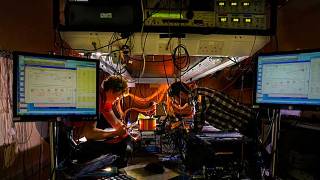Dec 2 2014
Heriot-Watt University will play a leading role in a new national network of Quantum Technology Hubs that has received almost £30m funding.
 Quantum communication research at Heriot-Watt University.
Quantum communication research at Heriot-Watt University.
Quantum mechanics
The hubs will explore the properties of quantum mechanics and how they can be harnessed for use in technology and be led by the universities of Birmingham, Glasgow, Oxford and York. Heriot-Watt University is leading partner of both the York and Glasgow quantum hubs.
Heriot-Watt’s research will push the limits of single photon imaging, enabling exciting new technologies that will allow us to see round corners or even through walls. It will also further development in quantum cryptography schemes which may eventually change the way we use secure e-commerce systems.
Institute of Photonics and Quantum Sciences
Director of Heriot-Watt’s Institute of Photonics and Quantum Sciences (IPaQS), Professor Gerald Buller, will lead the University’s activities in the Quantum Communications Hub coordinated by the University of York. Professor Daniele Faccio (also IPaQS) will lead activities within the Glasgow-led Hub. Heriot-Watt’s total funding package for these Hubs and two other recently announced EPSRC quantum technology projects is £6m.
Professor Gerald Buller said, "Heriot-Watt’s activities will concentrate mainly on the security provided by quantum digital signatures schemes developed by the University's focused theoretical and experimental research. Quantum digital signatures offer additional functionality to secure quantum communications, including the desirable properties of sender authentication and message transferability. We look forward to the exciting challenge of working towards implementation of these schemes in installed optical fibre networks.”
Professor Daniele Faccio said, “We are using cameras that are based on technologies developed for measuring single photons. These cameras can record motion at record-breaking speeds and have allowed us to see light as it propagates in free space. The next step will be to show that we can use this for a range of revolutionary applications such as seeing round corners or even directly through walls. The ability to capture light in movement is truly astonishing and allows us to push the boundaries of what we believe can or cannot be seen.”
Head of the School of Engineering and Physical Sciences Professor Steve McLaughlin said, “I am extremely pleased that the School of Engineering and Physical Sciences at Heriot-Watt has reinforced its position as a leader in photonics and quantum science and its involvement in the recently announced Quantum Hubs will lead to significant advances in the Science as well as ensuring that these advances are translated into new technologies in the future.”
Source: http://www.hw.ac.uk/